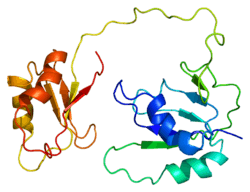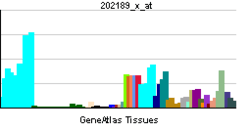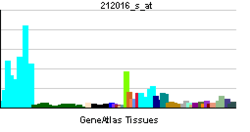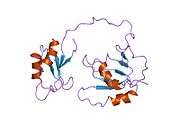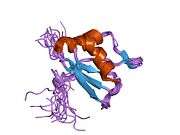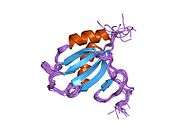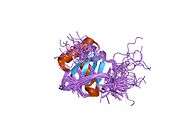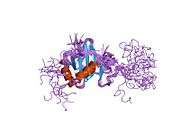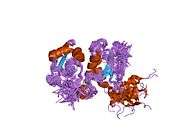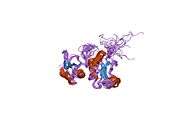PTBP1
| View/Edit Human | View/Edit Mouse |
Polypyrimidine tract-binding protein 1 is a protein that in humans is encoded by the PTBP1 gene.[3][4][5]
This gene belongs to the subfamily of ubiquitously expressed heterogeneous nuclear ribonucleoproteins (hnRNPs). The hnRNPs are RNA-binding proteins and they complex with heterogeneous nuclear RNA (hnRNA). These proteins are associated with pre-mRNAs in the nucleus and appear to influence pre-mRNA processing and other aspects of mRNA metabolism and transport. While all of the hnRNPs are present in the nucleus, some seem to shuttle between the nucleus and the cytoplasm. The hnRNP proteins have distinct nucleic acid binding properties. The protein encoded by this gene has four repeats of quasi-RNA recognition motif (RRM) domains that bind RNAs. This protein binds to the intronic polypyrimidine tracts that requires pre-mRNA splicing and acts via the protein degradation ubiquitin-proteasome pathway. It may also promote the binding of U2 snRNP to pre-mRNAs. This protein is localized in the nucleoplasm and it is also detected in the perinucleolar structure. Alternatively spliced transcript variants encoding different isoforms have been described.[5]
PTBP1 In Mammals
In brains of mammals, transcripts from the PTBP1 gene are missing one exon (exon 9) that is included in the brains of other vertebrates, as a result of alternative splicing. This contributes to the evolutionary difference between the nervous system of mammals and other vertebrates.[6]
Interactions
PTBP1 has been shown to interact with HNRPK,[7] PCBP2,[7] SFPQ[8][9] and HNRNPL.[7][10]
This gene is targeted by the microRNA miR-124. During neuronal differentiation, miR-124 reduces PTBP1 levels, leading to the accumulation of correctly spliced PTBP2 mRNA and a dramatic increase in PTBP2 protein.[11]
References
- ↑ "Human PubMed Reference:".
- ↑ "Mouse PubMed Reference:".
- ↑ Patton JG, Mayer SA, Tempst P, Nadal-Ginard B (August 1991). "Characterization and molecular cloning of polypyrimidine tract-binding protein: a component of a complex necessary for pre-mRNA splicing". Genes Dev. 5 (7): 1237–51. doi:10.1101/gad.5.7.1237. PMID 1906036.
- ↑ Romanelli MG, Lorenzi P, Morandi C (November 2000). "Organization of the human gene encoding heterogeneous nuclear ribonucleoprotein type I (hnRNP I) and characterization of hnRNP I related pseudogene". Gene. 255 (2): 267–72. doi:10.1016/S0378-1119(00)00331-0. PMID 11024286.
- 1 2 "Entrez Gene: PTBP1 polypyrimidine tract binding protein 1".
- ↑ Gueroussov, Serge; Gonatopoulos-Pournatzis, Thomas; Irimia, Manuel; Raj, Bushra; Lin, Zhen-Yuan; Gingras, Anne-Claude; Blencowe, Benjamin J. (August 2015). "An alternative splicing event amplifies evolutionary differences between vertebrates". Science. 349 (6250): 868–873. doi:10.1126/science.aaa8381.
- 1 2 3 Kim, J H; Hahm B; Kim Y K; Choi M; Jang S K (May 2000). "Protein-protein interaction among hnRNPs shuttling between nucleus and cytoplasm". J. Mol. Biol. ENGLAND. 298 (3): 395–405. doi:10.1006/jmbi.2000.3687. ISSN 0022-2836. PMID 10772858.
- ↑ Patton, J G; Porro E B; Galceran J; Tempst P; Nadal-Ginard B (March 1993). "Cloning and characterization of PSF, a novel pre-mRNA splicing factor". Genes Dev. UNITED STATES. 7 (3): 393–406. doi:10.1101/gad.7.3.393. ISSN 0890-9369. PMID 8449401.
- ↑ Meissner, M; Dechat T; Gerner C; Grimm R; Foisner R; Sauermann G (January 2000). "Differential nuclear localization and nuclear matrix association of the splicing factors PSF and PTB". J. Cell. Biochem. UNITED STATES. 76 (4): 559–66. doi:10.1002/(SICI)1097-4644(20000315)76:4<559::AID-JCB4>3.0.CO;2-U. ISSN 0730-2312. PMID 10653975.
- ↑ Hahm, B; Cho O H; Kim J E; Kim Y K; Kim J H; Oh Y L; Jang S K (April 1998). "Polypyrimidine tract-binding protein interacts with HnRNP L". FEBS Lett. NETHERLANDS. 425 (3): 401–6. doi:10.1016/S0014-5793(98)00269-5. ISSN 0014-5793. PMID 9563502.
- ↑ Makeyev EV, Zhang J, Carrasco MA, Maniatis T (August 2007). "The MicroRNA miR-124 Promotes Neuronal Differentiation by Triggering Brain-Specific Alternative Pre-mRNA Splicing". Mol. Cell. 27 (3): 435–48. doi:10.1016/j.molcel.2007.07.015. PMC 3139456
 . PMID 17679093.
. PMID 17679093.
Further reading
- Rasmussen HH, van Damme J, Puype M, et al. (1993). "Microsequences of 145 proteins recorded in the two-dimensional gel protein database of normal human epidermal keratinocytes". Electrophoresis. 13 (12): 960–9. doi:10.1002/elps.11501301199. PMID 1286667.
- Ghetti A, Piñol-Roma S, Michael WM, et al. (1992). "hnRNP I, the polypyrimidine tract-binding protein: distinct nuclear localization and association with hnRNAs". Nucleic Acids Res. 20 (14): 3671–8. doi:10.1093/nar/20.14.3671. PMC 334017
 . PMID 1641332.
. PMID 1641332. - Gil A, Sharp PA, Jamison SF, Garcia-Blanco MA (1991). "Characterization of cDNAs encoding the polypyrimidine tract-binding protein". Genes Dev. 5 (7): 1224–36. doi:10.1101/gad.5.7.1224. PMID 1906035.
- Raimondi E, Romanelli MG, Moralli D, et al. (1995). "Assignment of the human gene encoding heterogeneous nuclear RNA ribonucleoprotein I (PTB) to chromosome 14q23-q24.1". Genomics. 27 (3): 553–5. doi:10.1006/geno.1995.1093. PMID 7558043.
- Patton JG, Porro EB, Galceran J, et al. (1993). "Cloning and characterization of PSF, a novel pre-mRNA splicing factor". Genes Dev. 7 (3): 393–406. doi:10.1101/gad.7.3.393. PMID 8449401.
- Wu-Baer F, Lane WS, Gaynor RB (1996). "Identification of a group of cellular cofactors that stimulate the binding of RNA polymerase II and TRP-185 to human immunodeficiency virus 1 TAR RNA". J. Biol. Chem. 271 (8): 4201–8. doi:10.1074/jbc.271.8.4201. PMID 8626763.
- Black AC, Luo J, Chun S, et al. (1997). "Specific binding of polypyrimidine tract binding protein and hnRNP A1 to HIV-1 CRS elements". Virus Genes. 12 (3): 275–85. doi:10.1007/bf00284648. PMID 8883365.
- Huang S, Deerinck TJ, Ellisman MH, Spector DL (1997). "The Dynamic Organization of the Perinucleolar Compartment in the Cell Nucleus". J. Cell Biol. 137 (5): 965–74. doi:10.1083/jcb.137.5.965. PMC 2136227
 . PMID 9166399.
. PMID 9166399. - Oh YL, Hahm B, Kim YK, et al. (1998). "Determination of functional domains in polypyrimidine-tract-binding protein". Biochem. J. 331 ( Pt 1) (Pt 1): 169–75. PMC 1219335
 . PMID 9512476.
. PMID 9512476. - Hahm B, Cho OH, Kim JE, et al. (1998). "Polypyrimidine tract-binding protein interacts with HnRNP L". FEBS Lett. 425 (3): 401–6. doi:10.1016/S0014-5793(98)00269-5. PMID 9563502.
- Meissner M, Dechat T, Gerner C, et al. (2000). "Differential nuclear localization and nuclear matrix association of the splicing factors PSF and PTB". J. Cell. Biochem. 76 (4): 559–66. doi:10.1002/(SICI)1097-4644(20000315)76:4<559::AID-JCB4>3.0.CO;2-U. PMID 10653975.
- Kim JH, Hahm B, Kim YK, et al. (2000). "Protein-protein interaction among hnRNPs shuttling between nucleus and cytoplasm". J. Mol. Biol. 298 (3): 395–405. doi:10.1006/jmbi.2000.3687. PMID 10772858.
- Conte MR, Grüne T, Ghuman J, et al. (2000). "Structure of tandem RNA recognition motifs from polypyrimidine tract binding protein reveals novel features of the RRM fold". EMBO J. 19 (12): 3132–41. doi:10.1093/emboj/19.12.3132. PMC 203357
 . PMID 10856256.
. PMID 10856256. - Markovtsov V, Nikolic JM, Goldman JA, et al. (2000). "Cooperative Assembly of an hnRNP Complex Induced by a Tissue-Specific Homolog of Polypyrimidine Tract Binding Protein". Mol. Cell. Biol. 20 (20): 7463–79. doi:10.1128/MCB.20.20.7463-7479.2000. PMC 86300
 . PMID 11003644.
. PMID 11003644. - de Vries H, Rüegsegger U, Hübner W, et al. (2000). "Human pre-mRNA cleavage factor IIm contains homologs of yeast proteins and bridges two other cleavage factors". EMBO J. 19 (21): 5895–904. doi:10.1093/emboj/19.21.5895. PMC 305781
 . PMID 11060040.
. PMID 11060040. - Zang WQ, Li B, Huang PY, et al. (2001). "Role of Polypyrimidine Tract Binding Protein in the Function of the Hepatitis B Virus Posttranscriptional Regulatory Element". J. Virol. 75 (22): 10779–86. doi:10.1128/JVI.75.22.10779-10786.2001. PMC 114659
 . PMID 11602719.
. PMID 11602719. - Hüttelmaier S, Illenberger S, Grosheva I, et al. (2002). "Raver1, a dual compartment protein, is a ligand for PTB/hnRNPI and microfilament attachment proteins". J. Cell Biol. 155 (5): 775–86. doi:10.1083/jcb.200105044. PMC 2150882
 . PMID 11724819.
. PMID 11724819. - Kamath RV, Leary DJ, Huang S (2002). "Nucleocytoplasmic Shuttling of Polypyrimidine Tract-binding Protein Is Uncoupled from RNA Export". Mol. Biol. Cell. 12 (12): 3808–20. doi:10.1091/mbc.12.12.3808. PMC 60757
 . PMID 11739782.
. PMID 11739782.
